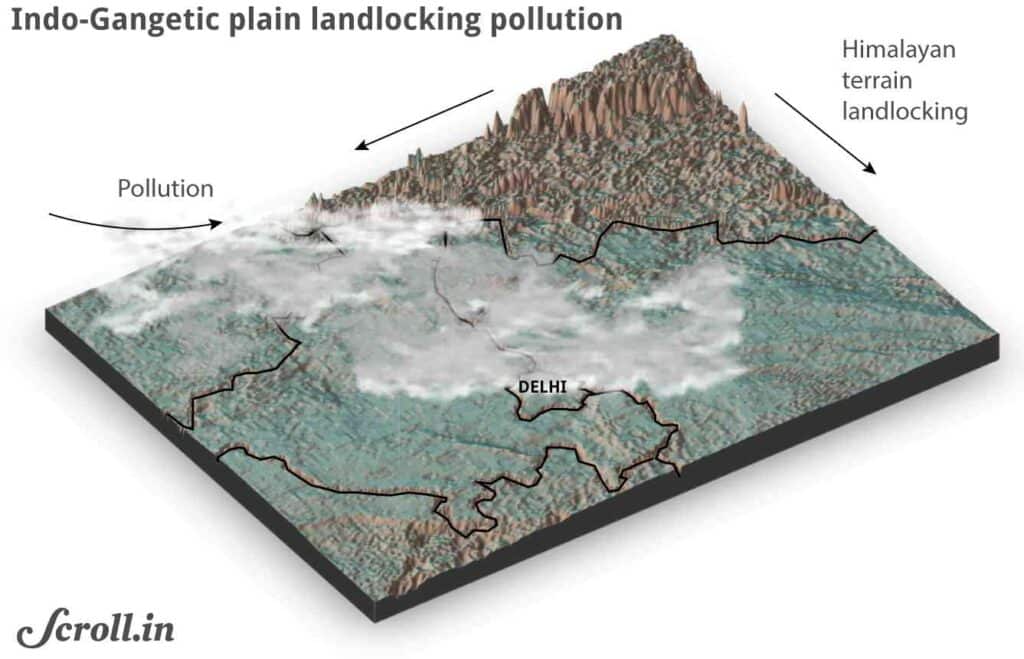Air Pollution in Delhi: A Polluted Capital
01 September 2024 – by Eric Koons
Air pollution in Delhi makes it one of the worst air quality rankings of any capital city. This issue is not only a local concern but also reflects the broader challenges of air quality management in India. Studies show that 42 of the world’s polluted cities are in India.
This leads to growing economic and health concerns for the for the Delhi, New Delhi and Delhi-NCR residents. Studies estimate that poor air quality reduces the lifespan of people living in Delhi by 11.9 years.
Delhi Air Pollution Level – How Polluted is Delhi Air?
Delhi’s air quality has significantly varied over the years. Data shows that while slight improvements have occurred during specific periods, the overall trend is declining air quality.

In the past decade, the PM2.5 levels in Delhi have often exceeded the safe limits set by the National Ambient Air Quality Standards (NAAQS) and the World Health Organisation (WHO). For example, in 2021, the average concentration of particulate matter was 20 times higher than the WHO air quality guidelines.
During winter months, these levels spike dramatically due to a combination of weather conditions, increased agricultural burning and Diwali celebrations. In contrast, the monsoon season improves air quality due to the rain washing away pollutants.
Delhi Air Quality Index
The air quality index (AQI) is a critical tool for understanding air quality and is calculated using a combination of particulate matter and pollutant concentrations. Delhi frequently records AQI values in the “severe” category, especially during winter. In November 2023, for instance, the AQI in some parts of Delhi reached over 400, indicating extremely hazardous conditions. During these periods, the entire population of Delhi is at risk of health issues, and most groups of people should avoid going outside.
Causes of Air Pollution in Delhi
Delhi’s air pollution stems from similar issues faced by India as a whole: vehicular pollution, industry, agriculture and natural factors.
Vehicular Emissions
Vehicles account for 38% of the city’s air pollution. This is no surprise, considering that car ownership has doubled since 2005. The city’s roads are struggling to keep up, and it is ranked as the 44th most congested city in the world. This results in long idle times for cars, which results in longer rides and higher vehicular emissions.
Industrial Pollution
Similarly, the country’s rapid industrialisation has brought a rise in industrial pollution. Factories, power plants and construction sites emit large quantities of pollutants, including sulfur dioxide (SO2), nitrogen oxides (NOx) and particulate matter.
Agricultural Practices
While not a local issue, agricultural practices in the neighbouring states of Punjab and Haryana significantly impact Delhi’s air quality, particularly during winter. Farmers in Punjab and Haryana often burn the leftover straw and stubble in their fields to clear the land for the next crop cycle. This practice releases large amounts of particulate matter and carbon monoxide into the atmosphere, which winds carry into Delhi.
Geographic Location
Lastly, Delhi is situated in a geographic location that makes it susceptible to natural air pollutants. Storms in the Thar Desert can carry large amounts of dust into the city, which is a basin surrounded by several mountain ranges. This contributes to temperature inversions during the winter months, which trap pollutants closer to the ground and reduce airflow.

How to Reduce Air Pollution in Delhi
Government Initiatives
Central and state governments have implemented several initiatives to combat ambient air pollution in India. The odd-even rule has been used periodically since 2016 and limits vehicles on roads based on license plate numbers, temporarily reducing traffic and emissions. However, it is not a long-term solution and is only used during periods of extreme air quality issues.
In a similar vein, the Graded Response Action Plan (GRAP) is an emergency response action starting when the city’s AQI reaches a “poor” rating. GRAP restricts activities associated with air pollution, such as construction and vehicles, that ramp up based on the city’s AQI ranking. This helps limit air quality issues before they spike.
While both of these initiatives are beneficial, they target air quality issues when they arise rather than limiting the root cause.
Technological Solutions
Technological solutions also play a growing role in addressing Delhi’s air pollution. Air purification systems like smog towers have been installed in various areas to filter harmful particulate matter – though the effectiveness of these air purifiers is debatable.

Air quality monitoring stations and data analytics are also becoming more important in providing real-time information. This data informs public awareness and government actions, such as those in GRAP. Additionally, data analytics help predict pollution trends, enabling targeted interventions.
Community and Individual Actions
Community involvement and individual actions are at the core of most environmental and health campaigns. Delhi’s outdoor and indoor air pollution issues are no different.
Awareness campaigns like “Red Light on, Gaadi Off” educate the public on pollution sources and encourage behaviours like switching off vehicles at traffic lights. Community-led initiatives, including local air quality monitoring, further mobilise residents to act. Additionally, green practices, such as using solar energy and participating in urban gardening, enhance air quality and environmental health.
Air Pollution as a Global Challenge
While air pollution in Delhi is a pressing local issue, it is part of a much larger global challenge. Cities around the world, from Manila to Mexico City, grapple with severe air pollution due to industrialisation, urbanisation and increasing traffic. These shared struggles highlight the need for international cooperation in addressing air quality.
Air pollution is a transboundary problem, with pollutants often travelling across borders, affecting regions far from their source. Moreover, many air pollutants contribute to climate change, linking local air quality issues to global environmental concerns. International agreements, like the Convention on Long-Range Transboundary Air Pollution, emphasise the importance of reducing emissions worldwide to improve air quality and combat climate change.
by Eric Koons
Eric is a passionate environmental advocate that believes renewable energy is a key piece in meeting the world’s growing energy demands. He received an environmental science degree from the University of California and has worked to promote environmentally and socially sustainable practices since. Eric’s expertise extends across the environmental field, yet he maintains a strong focus on renewable energy. His work has been featured by leading environmental organizations, such as World Resources Institute and Hitachi ABB Power Grids.
Read more







